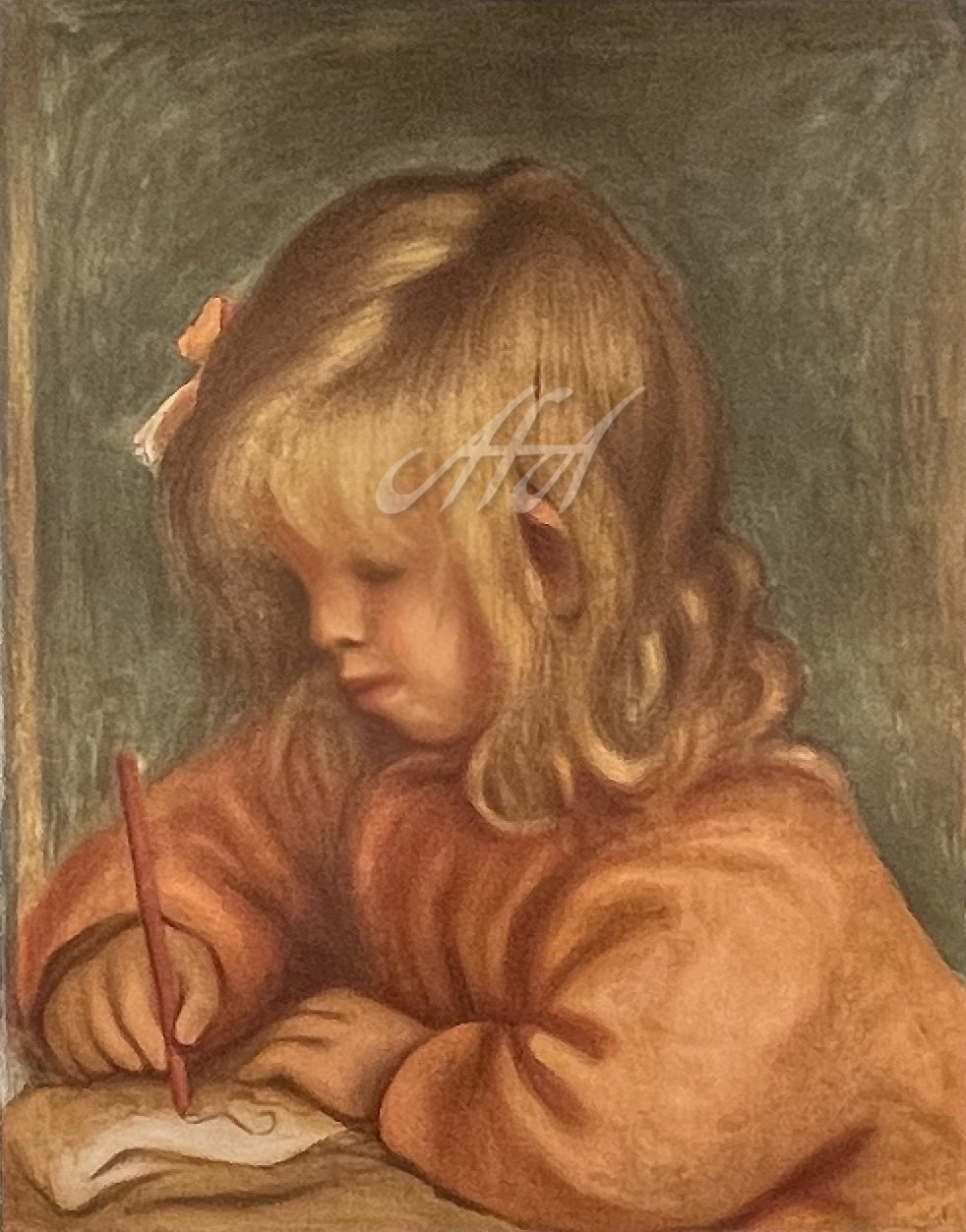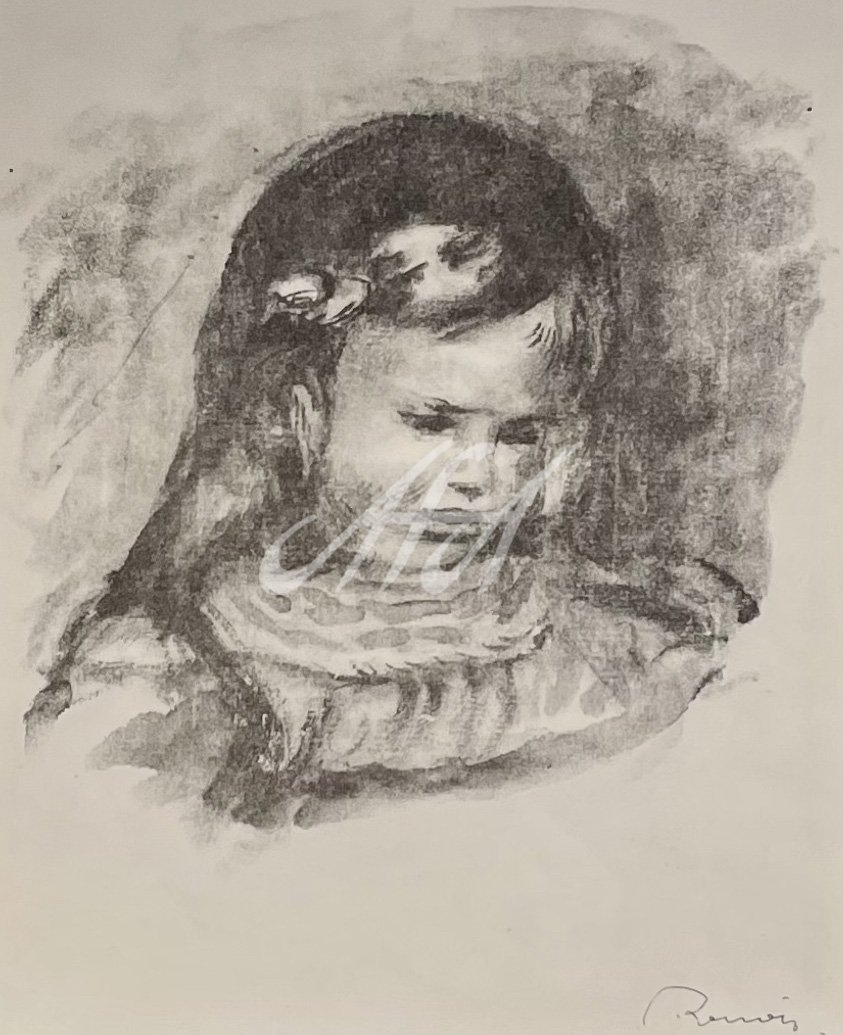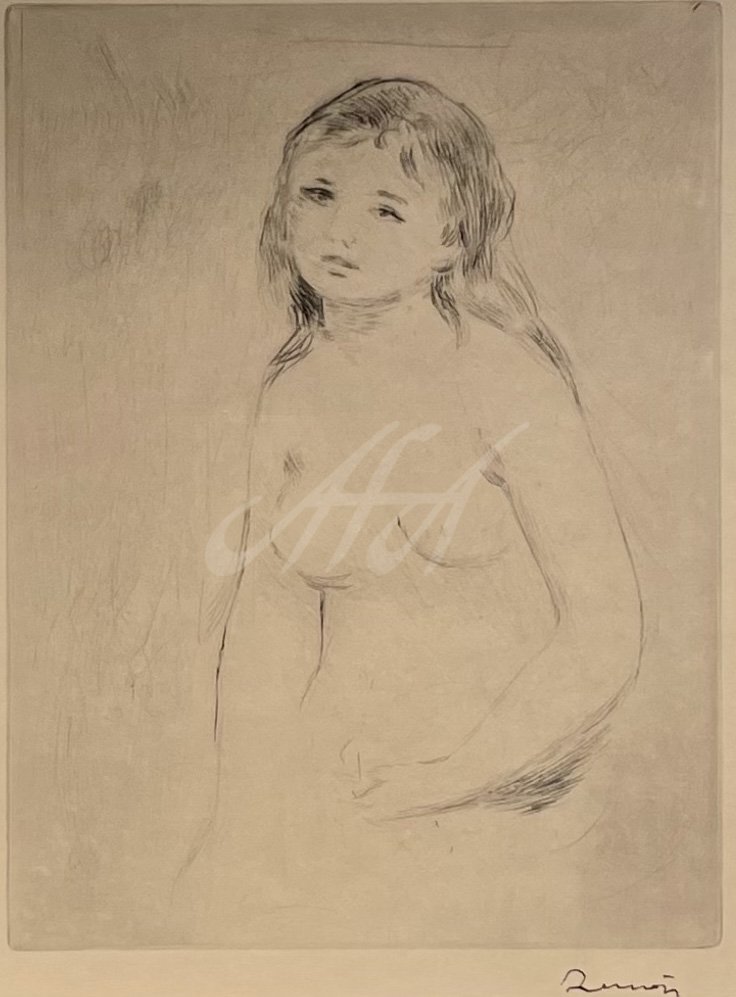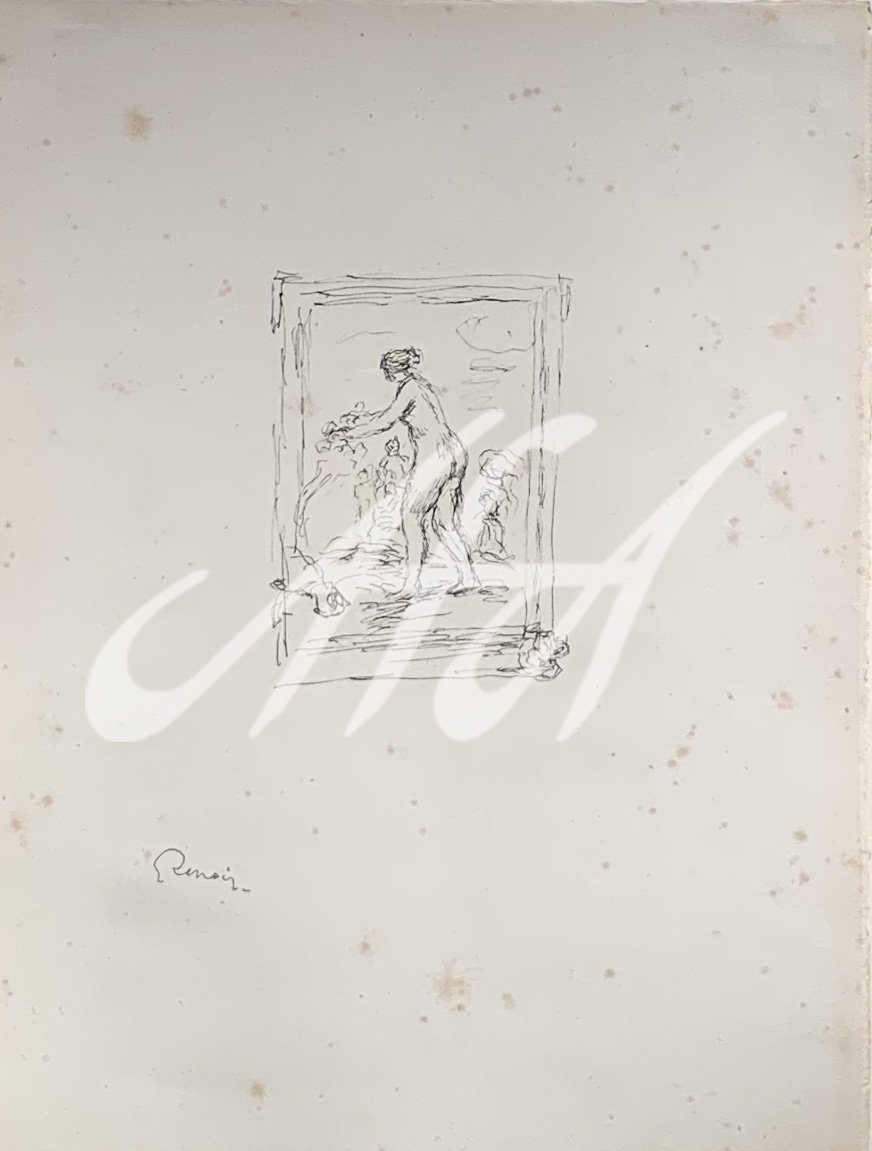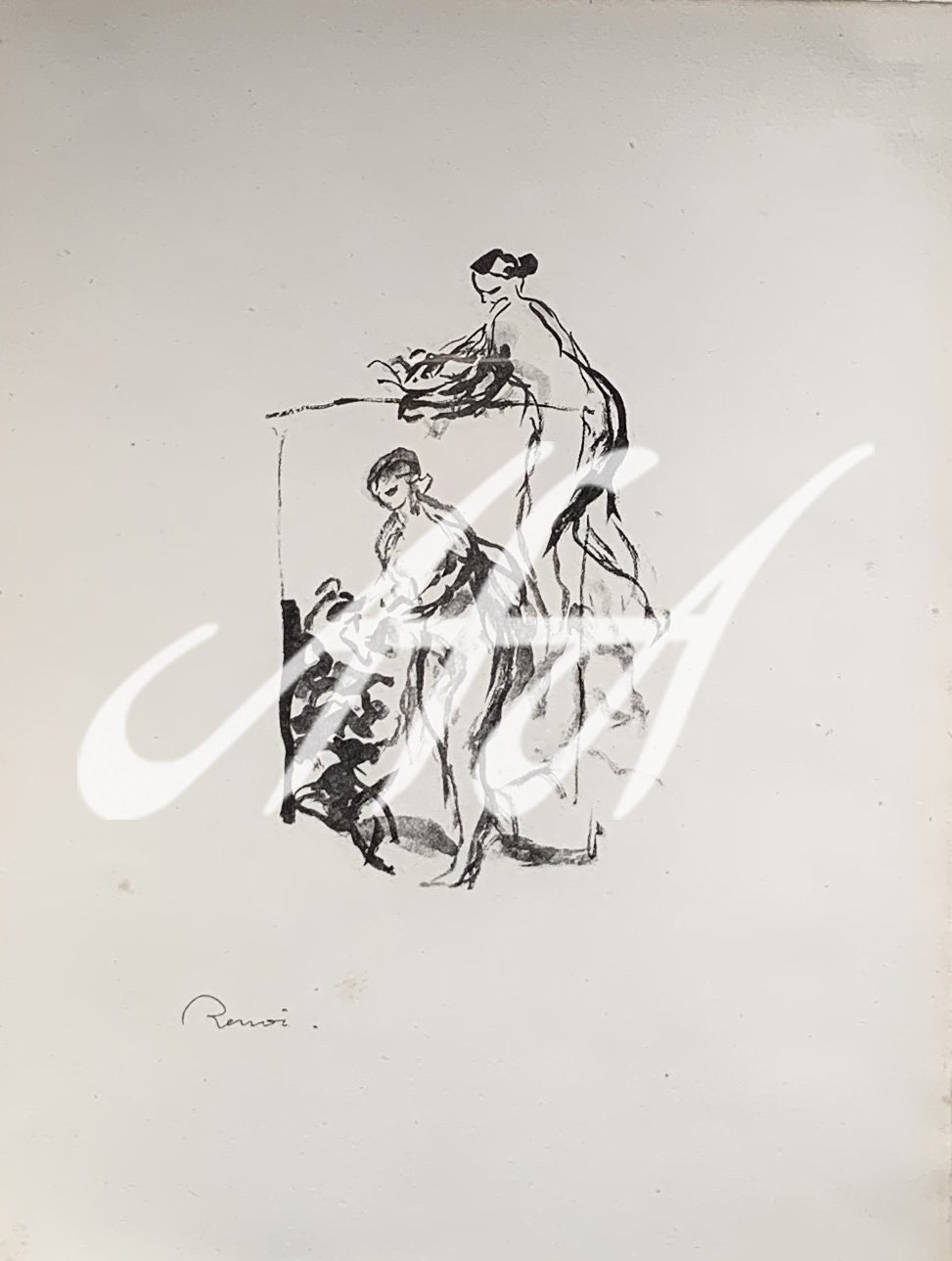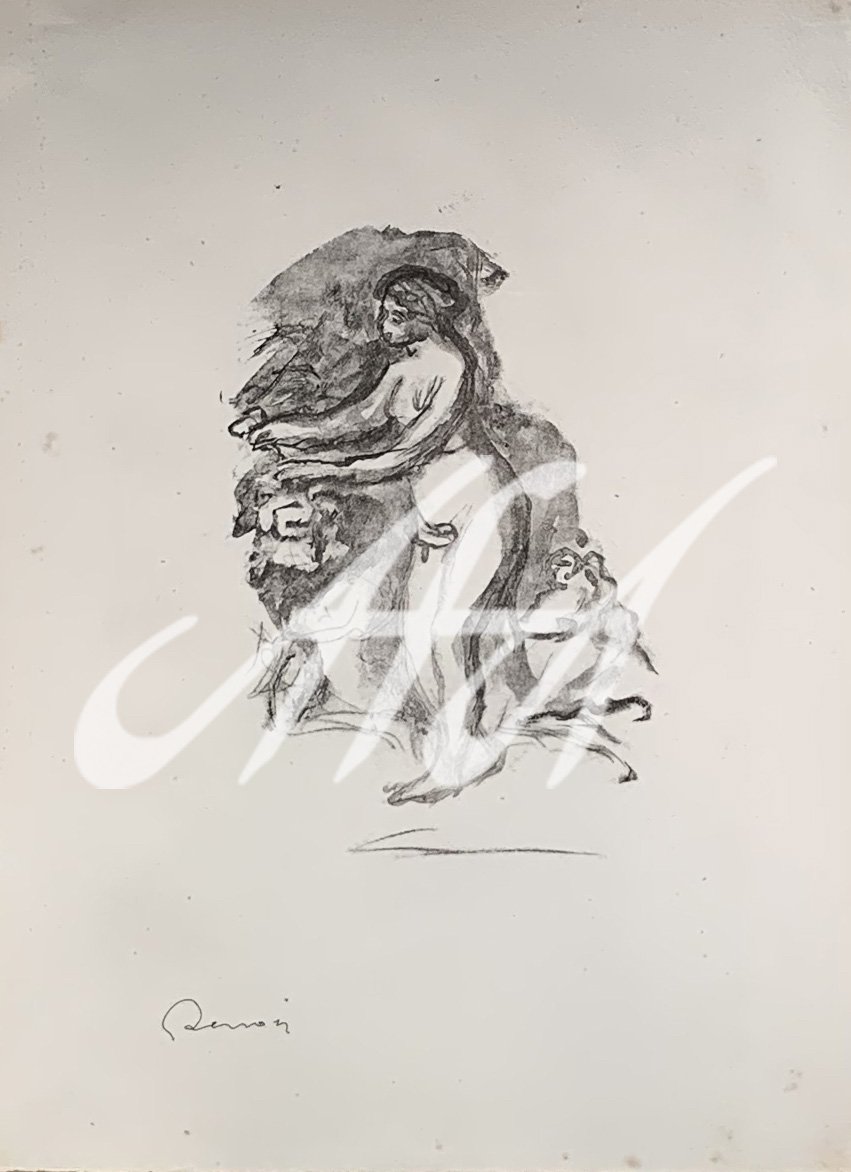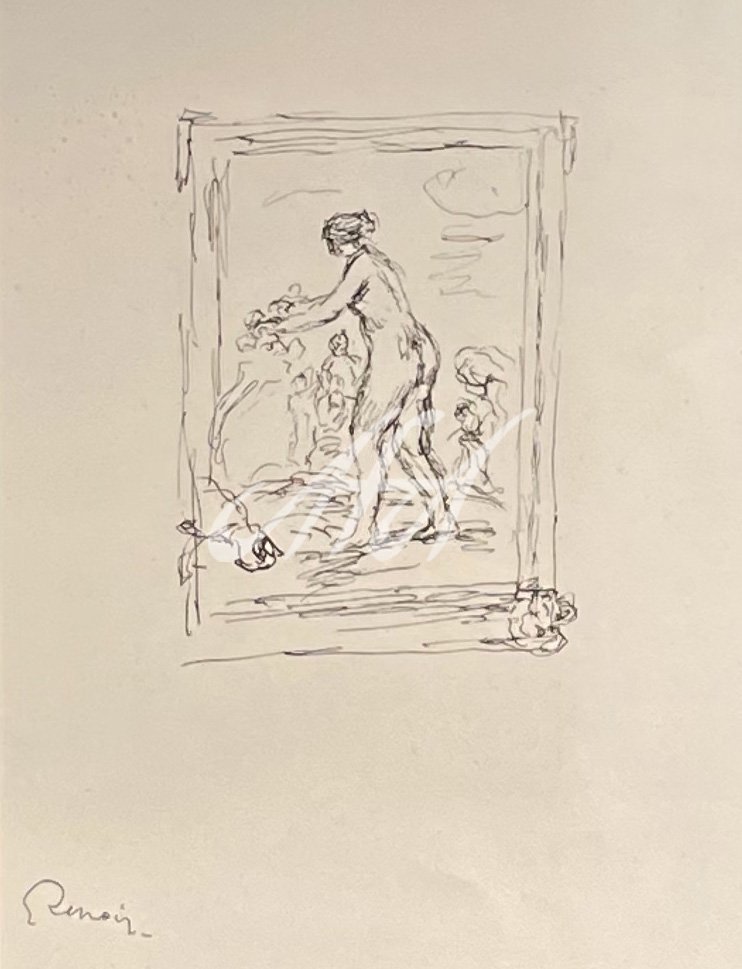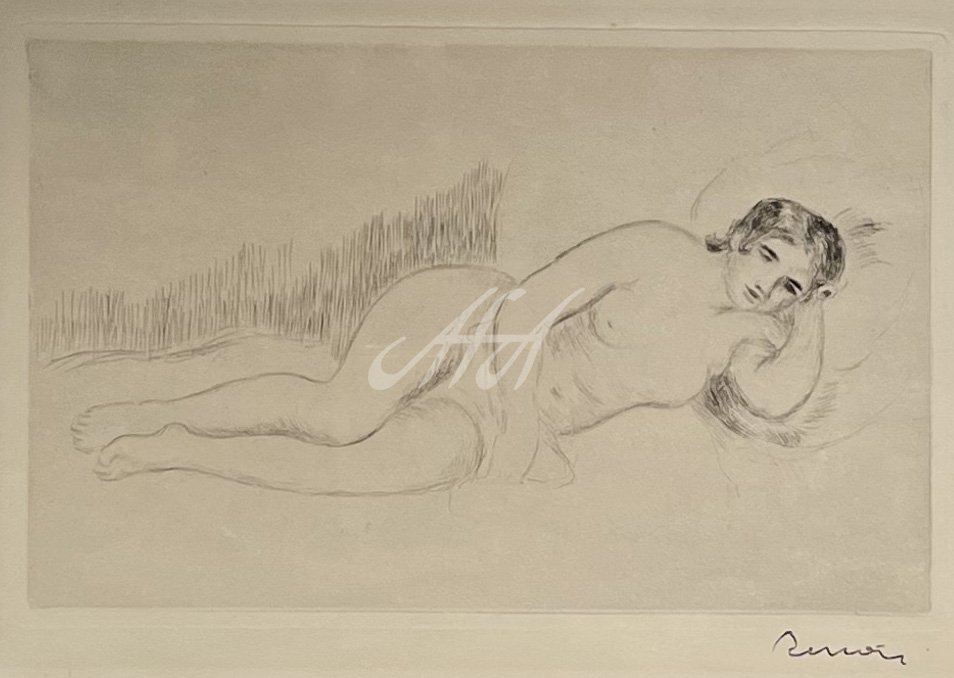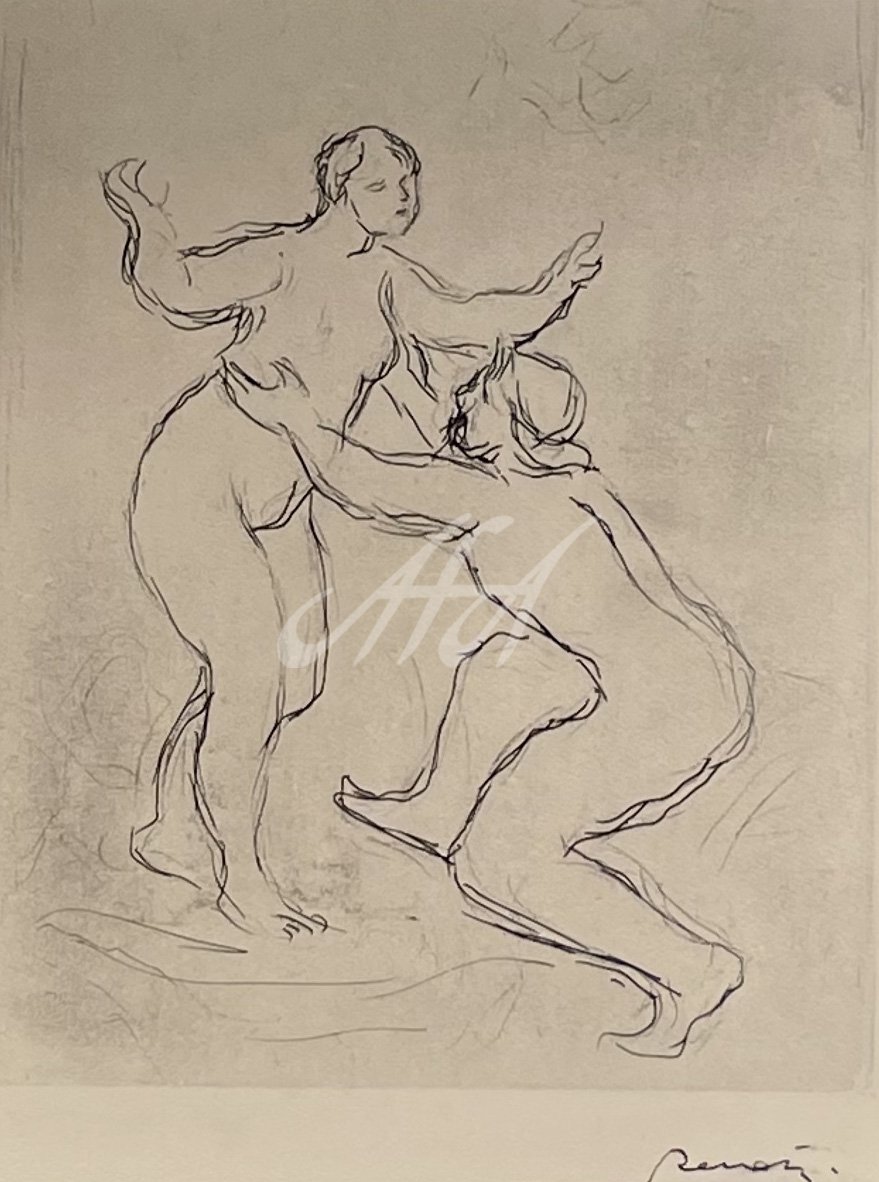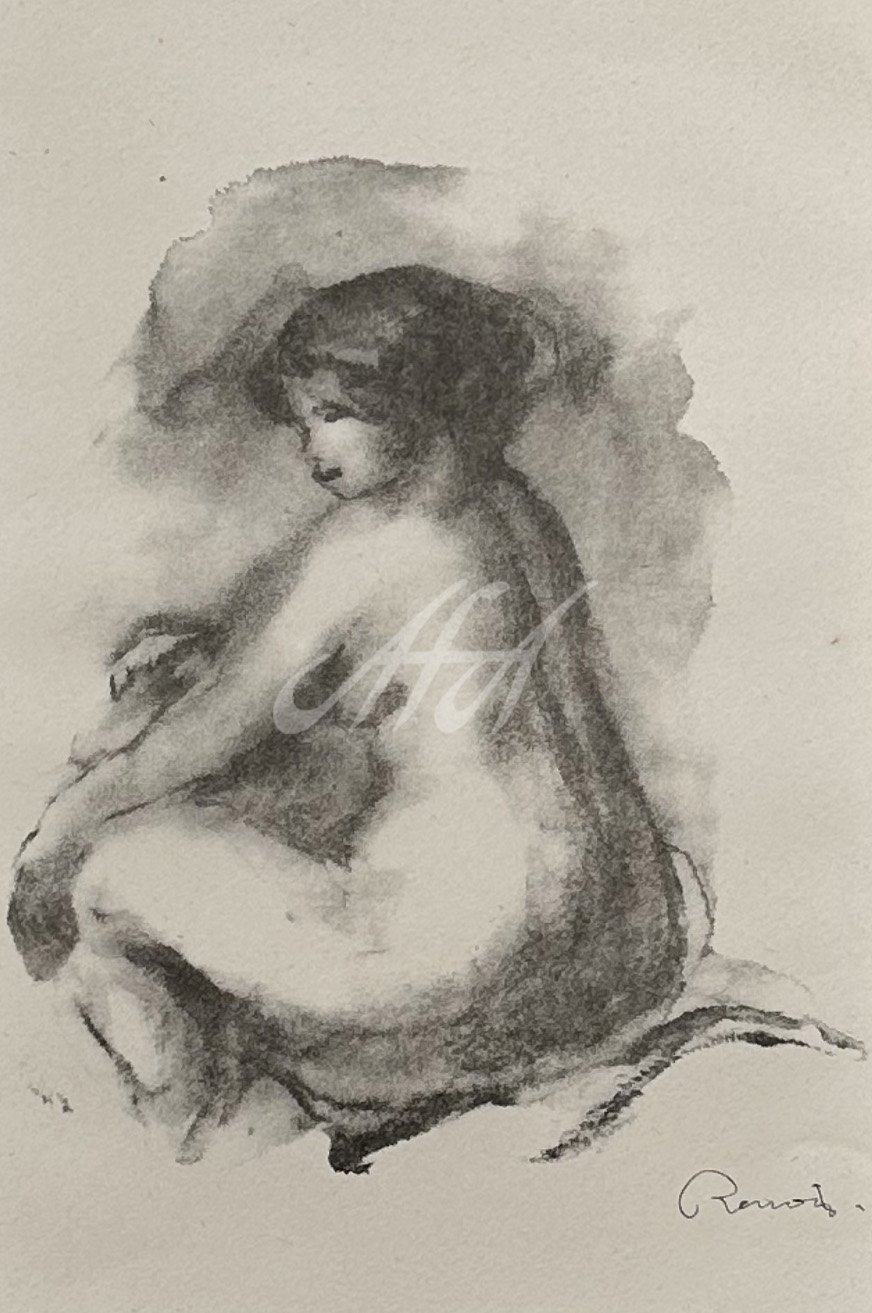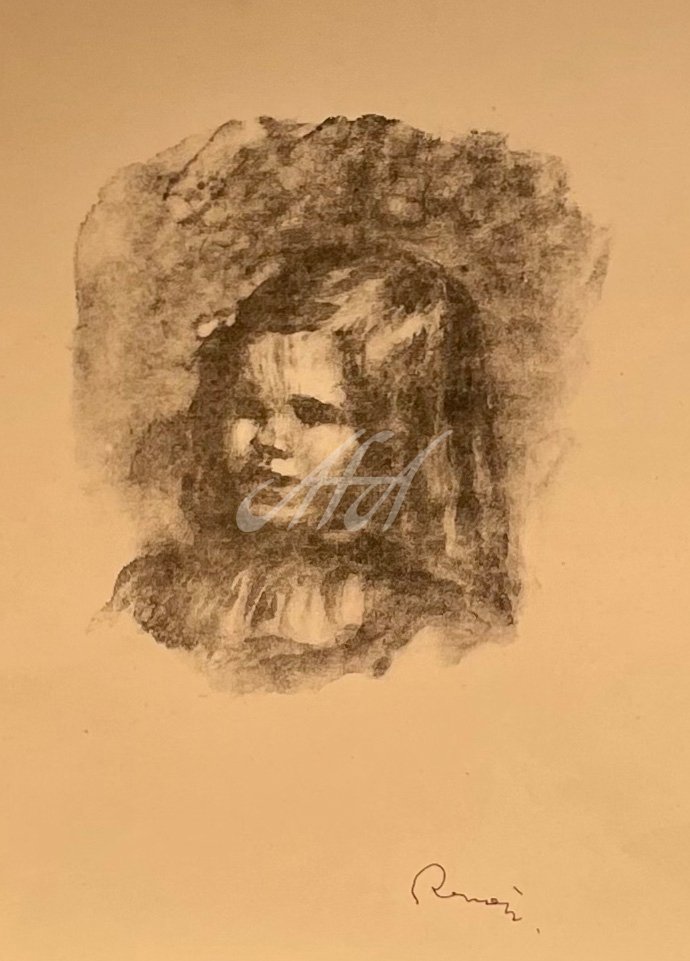Pierre-Auguste Renoir
(French, 1841- 1919)
“If painting were not a pleasure to me I should certainly not do it.”
— Renoir
Renoir is recognized across the globe as one of the greatest painters of the Impressionist period, the momentous time that was the launching point for modern art in a world of historically traditional art. Impressionism appeared in the late 1860s, and fully bloomed over the next three decades. The youngest member of the Impressionists, Pierre-Auguste Renoir was essential to developing the radical style, which was focused on conveying realistic light effects and optical sensations in nature, like the difference between perceived color and local color. Perceived color is the color that reaches your eye, that you actually experience, and is highly dependent on light pockets, shading, other colors in the area, and the color of the lighting, etc., whereas local color is the simple expected color of the object. An apple in the dark would still be called red if you were referring to its local color. While highlighting and shading had become more prominent during the Renaissance than previously, academic artists were still engaging much more heavily with local color. The Impressionists were the first movement to really start working in depth with perceived color.
His dappled movement of light and shadow, his feathery paint application, and the human aspect often distinguish Renoir’s early work. He had a keen eye for intimate domesticity and, as the son of a tailor and a seamstress, also for fashion, and his depictions of content families and well-dressed Parisian pleasure-seekers linked the experimental drive of Impressionism to the public. While his mature work returned to incorporating elements of traditional academic art, like smoother textures, bolder contouring, and more nudes and classic subjects/poses, alongside a luminous Impressionist palette, it was historically significant as elements of it also influenced the paths of modernism. Renoir had three recognizable periods, his Impressionist period was in his younger years, then his Ingres period after that, and his late work was an interesting combination of the two, but the latter two didn’t achieve quite the same critical acclaim as the first.
Known for his hedonistic subject matter, as well as his feathery brushstrokes and rich, bright palette- especially in comparison to the dark earthy colors of Renaissance and Baroque art, Renoir created charming scenes of carefree Parisians and sensual nudes in his own distinct style, overloaded with painterly sensuality. Although he is on multiple lists of the top twenty most famous artists ever, the artist’s work is controversial and received and continues to receive criticism for his work being overly idealized and saccharine, with some critics going as far as to call it gauche and insipid. While some have had very passionate criticism indeed, simultaneously his work is revered by and entrances many. He always intended for his work to be about the finer things, which is why he’s called “the painter of happiness”, but despite the light-hearted subject matter, he was a thoughtful and complex painter. As he studied the Old Masters at the Louvre in his youth, he was particularly influenced by the sensual Rococo paintings of Watteau. The intentionally over-excessive Rococo art was also criticized in its time for being superficial and ridiculous. Renoir stayed true to his vision with deliberation and through great difficulty. Through the loss of the use of his legs, millions perishing in the trenches in World War I, his two elder sons being seriously wounded in combat, and his wife of 25 years dying all in five years, Renoir kept depicting bliss and taking sanctuary in subjects of pleasure. “His nudes and his roses declared to the men of this century, already deep in their task of destruction, the stability of the eternal balance of nature,” his son Jean Renoir explained. Hedonism maintains that pleasure, in the sense of the satisfaction of desires, is the highest good and proper aim of human life. Renoir at least believed in it for his paintings, saying, “To my mind, a picture should be something pleasant, cheerful, and pretty, yes pretty! There are too many unpleasant things in life as it is without creating still more of them.”
Of the original Impressionists, Renoir was the first to move away from the ultramodern direction, and he began using more composition and structure, and referencing High Renaissance art like Raphael, Titian, and Rubens in what is called his Ingres period. From the early 1880s to 1888, he rejected Impressionism and there are little to no traces of modernism in his work, except for the luminous colors, as he returned to traditional art. Although not without appreciation, this has been widely disregarded as something of a step backwards, but it did lead to his late period, in which the modernist works that were indispensable for modernist progression. Future modern art movements like Fauvism and Cubism, while still moving away from traditional art, were also thinking more about issues like composition, depth, and color rather than the fleeting moments of Impressionism. In 1888, he changed direction again, saying ‘I have taken up again, never to abandon it, my old style, soft and light of touch.’ His later periods came to be considered overly involved in antiquated nostalgia and eclipsed by Cubism and Abstract art. Some major museums have parted with late Renoirs that were in their possession because they didn’t seem to fit with the story of modern art that they’re telling, but these works played a key and often overlooked role in influencing great artists, like Picasso, Matisse, Bonnard, and Maillol. This was demonstrated in the Renoir in the 20th Century exhibition, which travelled from Paris to LA to Philadelphia in 2010. For example, his 1895-1900 painting Eurydice uses a classical pose, but the nude subject has disproportionately large hips and thighs against an Impressionist, diffusely painted Mediterranean landscape of pastel green and violet hues. “It was just this free interpretation of a traditional subject, this sense of liberty, that captivated Picasso,” Sylvie Patry, author of the book, Renoir: Father and Son/Painting and Cinema says. The painting was one of seven Renoir paintings and drawings Picasso collected, and a likely inspiration for his 1921 canvas Seated Bather Drying Her Feet.
Pierre-Auguste was born in Limoges, France, in 1841 to a working-class family. As a childhood, he had a natural talent for singing and almost became a professional member of the Saint Eustache Opera Choir, taking lessons with Charles Gounod, who later composed Ave Maria and several successful operas, however he instead became an apprentice at a porcelain factory where he copied floral patterns onto the China by hand and became interested in art. At age 21 in 1862, he began studying under Charles Gleyre and attending the famous Ecole des Beaux Arts in Paris, where he met other rising artists like Claude Monet, Alfred Sisley, and Frédéric Bazille. He didn’t always have enough money to buy paint, but he did live close to the Louvre where he frequently did self-study. In 1864, the prestigious annual Paris Salon featured his work, and he began doing portrait commissions.
In 1866, Renoir began frequently plein air painting in the forest of Fontainebleau with the influential Barbizon painters. Interestingly, during this time, Renoir is known to have hidden the young far-left revolutionary Raoul Rigault in the forest of Fountainebleu for several weeks. Rigault was near starvation and in need of shelter while he was on the run from Napoleon III’s police. By 1869, the artist was working beside the water at La Grenouillère with Monet. Together the two men developed several of the theories, techniques, and practices that would define Impressionism. Occasionally during the 1860s, Renoir and Monet submitted paintings that were accepted into the famous Salon exhibitions. But in the 1870s, both artists’ works were repeatedly rejected, in part due to tense, large-scale political situations, like the War of 1870, in which the German states tried to unify, but were opposed by France which was defeated in its attempt to regain its European dominance. When the war ended, progressive members of the French National Guard, who had been in Paris to defend it, took physical control of the city of Paris with socialist, anarchist, and feminist goals. They attempted to create their own independent government, the Commune of Paris, from March to May of 1871, instead of joining the new French government, the Third Republic. The Communards captured Renoir, who had returned to Paris after army service in the War of 1870, believing he was a spy for the French Army. They almost killed him on the spot but decided to take him to the town hall to be executed, where the leader of the insurrection recognized him. It was Raoul Rigault. Rigault vouched for Renoir, and so they saved each other’s lives.
Eventually, Monet and Renoir stopped submitting pictures to the Salons and Monet started his own independent artists’ society. Renoir was one of the first to join. He displayed six paintings in the first ever exhibition of the Impressionist school in April 1874. While there was overall continual academic and public disapproval for the giant break from traditional art, there was some approval. Painting enthusiast and collector Victor Chocquet for example was a champion for the movement and energetically exerted himself at the exhibitions trying to get objectors to see the value in the changes one person at a time. Still, it took ten years for Impressionism to establish its following and determine its vision. With the birth of Impressionism, Renoir’s significance was cemented. He became widely known, and the art world changed forever.
He travelled in the early 1880s to study the great Renaissance and Baroque masters, which is when his style first changed significantly. These works became called his “Ingres” period as he used a linear classical style influenced by the work of Ingres and Boucher. He now worked more in a studio than in the open air, and more fixated on the female form and mythology. Renoir admitted without embarrassment that for him, the most beautiful part of a female's body was her buttocks, and mentioned that if God had not created breasts, he might not have become a painter. In 1885 at age 44, he had his first child, Pierre, with Aline Charigot, who had been one of his models for five years. Three years later in 1888, the artist was afflicted with facial paralysis and rheumatoid arthritis, the latter of which would get worse over the next thirty years.
Public recognition started to come in 1890, when Durand-Ruel held a large exhibition of his work, and one work was purchased by the French state for the Musée du Luxembourg. He and Aline married in the same year. From the 1890s on, he returned to his soft, feathery brushstrokes and there was a fresh emphasis on color and sensuality in his depictions of the idyllic lives of sweet, bourgeois girls.
In 1894, they had their second son, Jean, and then in 1898, illness resulted in the paralysis of Renoir’s right arm, with deformation of his hands and arms setting in two years later. In 1901, he was made a Chevalier of the Legion d’Honneur (an honor his son Jean would also receive for film about 40 years later). Also in 1901, at age 60, the couple had their third and final child, Claude. 1910 saw the paralysis of Renoir’s legs, and he was thereafter confined to a wheelchair. Aline passed away in 1915, at age 56, apparently weakened after Pierre and Jean sustained serious injuries during WWI.
The artist painted for the remainder of his life, despite becoming so arthritic that he regularly had his brushes taped to his hands. He often painted with one of his many cats on his lap to keep him warm as he grew older, and art experts have even used cat hair in the paint to authenticate some of his works. At age 78, Renoir visited the Louvre to see his paintings hanging amongst the masterpieces of the old masters he had long venerated. Later that year, on December 3, 1919, he passed away of pneumonia. He is buried in Essoyes next to Aline. After his death, his son Jean, a successful film director, kept his father’s name a prominent one in French culture.
Renoir created Bal au Moulin de la Galette (Dance at the Pancake Mill) in 1876, which would become his most famous painting and a celebrated Impressionist masterpiece. It depicts the joyous open-air revelry of a Sunday afternoon at the dancehall and café in Montmartre with loose brushwork and vibrant colors, and showcases Renoir’s ability to capture glittering, dappled light. It was sixth on the list of most expensive paintings ever sold, when adjusted for inflation, in January 2013, and a smaller version of it was 13th on the list as of February 2016. The second most expensive Impressionist work is a version of Renoir's Moulin de la Galette, which sold for $78.8 million in 1990, giving it an adjusted price of almost $200 million. Renoir’s other world-renowned masterpiece is Le dejeuner des canotiers (Luncheon of the Boating Party) from 1881, which is one of the most admired paintings of the past 150 years.
Over the course of his life, Renoir created several thousand paintings, and their sensuality made his works some of the most famous and frequently reproduced in the history of art. He was a major recorder of the Belle Époque, one of the original explorers of Impressionism and thus a herald of modernism itself, while his later work directly influenced modernist giants. Although the artist found commercial success relatively quickly, he seemed to be driven primarily by his enjoyment of the act of painting and his modernist journey is historically significant and truly distinct from others. The single largest collection of his works, 181 paintings, is at the Barnes Foundation, near Philadelphia, Pennsylvania. Renoir's body of work is found in the world's best museums, particularly those of northern Europe and the United States.
American Fine Art, Inc. is proud to feature the original works and limited editions of Pierre-Auguste Renoir. Visit our 12,000 sq. ft. showroom in Scottsdale, Arizona or call today. Our website is offered only as a limited place to browse or refresh your memory and is not a reflection of our current inventory. To learn more about collecting, pricing, value, or any other art information, please contact one of our International Art Consultants. We look forward to giving you the one on one attention you deserve when building your fine art collection. We hope you find our website helpful and look forward to seeing you in Scottsdale soon.

